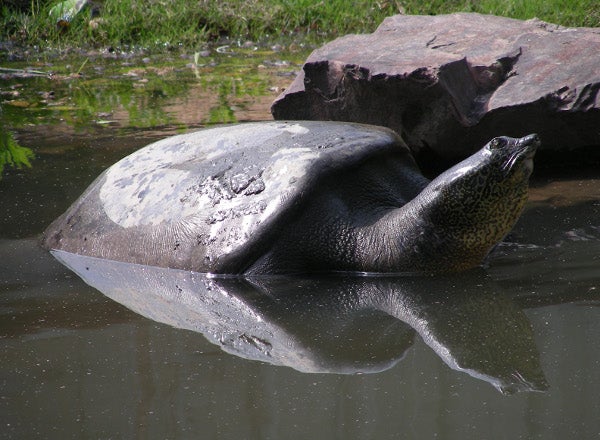This article was published in Scientific American’s former blog network and reflects the views of the author, not necessarily those of Scientific American
I have written about a lot of causes of extinction over the years.
Climate change. Disease. Overhunting. Pollution. The list goes on and on.
Well here’s a new one that could end up on the list: a mangled penis.
On supporting science journalism
If you're enjoying this article, consider supporting our award-winning journalism by subscribing. By purchasing a subscription you are helping to ensure the future of impactful stories about the discoveries and ideas shaping our world today.
Now, normally a single set of damaged sexual organs wouldn’t make that much of a difference in the grand scheme of things. But nothing about the Yangtze giant softshell turtle (Rafetus swinhoei) is normal. Only a single mated couple of this species remains anywhere in the world. The two massive turtles, each estimated at more than a century old, have lived together in captivity at China’s Suzhou Zoo since 2008. (Two other Yangtze turtles, both male, live in Vietnam.) Although they have engaged in mating behavior several times over the years, the female has never laid fertile eggs.
No one knows how long these two turtles will live, but time is obviously of the essence. And so, with the clock ticking, scientists set out to see why fertilization has not yet occurred. That meant finding out if the male turtle still had viable sperm.
Collecting a sample of his little swimmers proved...challenging. “At first we tried semen collection through manual stimulation and the use of a vibrator,” Gerald Kuchling of the Turtle Survival Alliance (TSA) said in a prepared release. Luckily, no photos of these procedures were provided.
Alas, neither of those methods worked. The scientists still had one more trick up their sleeves, though. Previous research into another softshell turtle showed that sedating the animal and using a technique called electro-ejaculation might be the way to go. Those are risky procedures for a centenarian male, but the team of scientists dedicated to saving the species from extinction decided that it was the only way to go.
The researchers anesthetized the turtle. That’s when they discovered the damaged sex organs, which they theorized may have been caused by a fight with another male many decades ago, back when there actually were males to fight. The damage wasn’t severe enough to prevent copulation but it is enough to block insemination.
Long story short, they got their sample and not long after the female met her new boyfriend, Mr. Turkey Baster.

Now the waiting begins. First, the female is expected to lay a clutch of as many as 60 eggs in the next few weeks. After that we’ll find out if they are fertile. “Many reptiles have a change in the appearance of the egg called ‘banding’ or ‘chalking’ when they are fertile and in the early stages of incubation,” says Paul Calle, chief veterinarian for the Wildlife Conservation Society's Bronx Zoo, who worked with Chinese veterinarians on the sedation process. The process only takes a few days, “so if these eggs go through that change, it will indicate that they are fertile,” he says.
Then we wait again to see if the eggs hatch. If that happens, chances are good that the species will actually be saved from extinction. “The gene pool will obviously be small, but having babies obviously would be very good for the species,” Calle says. “Without babies there is no hope.” The other two males in Vietnam could also conceivably be called into action to diversify the gene pool, because the female can lay several clutches a year.
The next step, many moons from now, would be to get any newborns to also breed and further expand the species. That probably won’t happen for at least another 10 to 15 years, says Fort Worth Zoo biologist and TSA president Rick Hudson. For now, though, any eggs hatching will be victory enough for this critically endangered species.
Photos by Gerald Kuchling, courtesy of the Wildlife Conservation Society